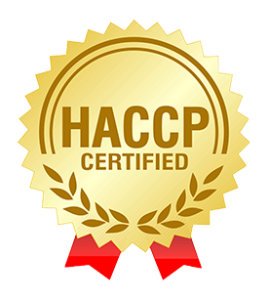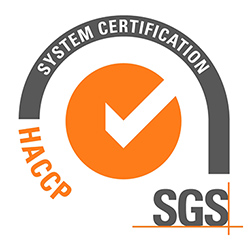[subtitle]HACCP standard – Implemented at Burjan since 2008.[/subtitle]
HACCP – Hazard Analysis And Critical Control Points Systems
The critical aspects of manufacturing and distribution of food are the quality, but also the safety. HACCP is integrated set of satety controls during all phases of manufacturing and distribution.
[row]
[two_third_column]
What is HACCP standard?
Hazard analysis and critical control points or HACCP is a systematic preventive approach to food safety from biological, chemical, and physical hazards in production processes that can cause the finished product to be unsafe, and designs measurements to reduce these risks to a safe level.
In this manner, HACCP is referred as the prevention of hazards rather than finished product inspection. The HACCP system can be used at all stages of a food chain, from food production and preparation processes including packaging, distribution, etc.
Since 1970’s HACCP has been established as the international set of standards for manufaturing of safety food. It’s also adopted by the WHO (World Health Organization) as an effective tool to prevent food-transmited diseases.
Application of HACCP is one of basic requirements before any food exporting arrangements has been made and desired conquering of European market.
[/two_third_column]
[one_third_column]
Why do we apply HACCP?
Application of HACCP is widely spread across the globe, while legally binding in EU countries (Council Directive 93/43/EEC, replaced on 29th April, 2004 by regulative 852/2004/EC).
Since 01st January, 2009 application of HACCP is obligatory for all food manufaturers in the Republic of Serbia.
[/one_third_column]
[/row]
Seven principles – A foundation of HACCP System
 1. Conduct a hazard analysis – Plans determine the food safety hazards and identify the preventive measures the plan can apply to control these hazards. A food safety hazard is any biological, chemical, or physical property that may cause a food to be unsafe for human consumption.
1. Conduct a hazard analysis – Plans determine the food safety hazards and identify the preventive measures the plan can apply to control these hazards. A food safety hazard is any biological, chemical, or physical property that may cause a food to be unsafe for human consumption.
2. Identify critical control points – A critical control point (CCP) is a point, step, or procedure in a food manufacturing process at which control can be applied and, as a result, a food safety hazard can be prevented, eliminated, or reduced to an acceptable level.
3. Establish critical limits for each critical control point – A critical limit is the maximum or minimum value to which a physical, biological, or chemical hazard must be controlled at a critical control point to prevent, eliminate, or reduce to an acceptable level.
4. Establish critical control point monitoring requirements – Monitoring activities are necessary to ensure that the process is under control at each critical control point. In the United States, the FSIS requires that each monitoring procedure and its frequency be listed in the HACCP plan.
5. Establish corrective actions – These are actions to be taken when monitoring indicates a deviation from an established critical limit.
6. Establish procedures for ensuring the HACCP system is working as intended – Validation ensures that the plants do what they were designed to do; that is, they are successful in ensuring the production of a safe product. Verification ensures the HACCP plan is adequate, that is, working as intended.
7. Establish record keeping procedures – The HACCP regulation requires that all plants maintain certain documents, including its hazard analysis and written HACCP plan, and records documenting the monitoring of critical control points, critical limits, verification activities, and the handling of processing deviations. Implementation involves monitoring, verifying, and validating of the daily work that is compliant with regulatory requirements in all stages all the time.
The advantages of applying the HACCP?
HACCP realy does pay out, since it prevents incidents-related expenses and unnecessary waste.
HACCP also protects the manufacturer from a possible negative publicity. By applying this set of standards, manufacturer can easily deny any complaint from the costumer, whether it’s justified or not.
Conclusion
The essential idea behind HACCP is to prevent an accident.
HACCP has two basic components:
– HA – Conduct a hazard analysis. Plans determine the food safety hazards and identify the preventive measures the plan can apply to control these hazards. A food safety hazard is any biological, chemical, or physical property that may cause a food to be unsafe for human consumption.
– CCP (critical control points) – is a point, step, or procedure in a food manufacturing process at which control can be applied and, as a result, a food safety hazard can be prevented, eliminated, or reduced to an acceptable level.
Comparison with other control systems
 Control of food integrity, based on testing the final products, is obligatory by the Law on Health integrity of food and genaral purpouse objects.
Control of food integrity, based on testing the final products, is obligatory by the Law on Health integrity of food and genaral purpouse objects.
Regardless of it’s comprehensiveness and rigorousness this system is incapable to prevent accident situations and food poisoning, as well as contamination by microbiological, chemical and physical agents.
Besides, this way of control is expensive, it takes a lot of time and significantly slows down the manufacturing and distributing processes.
Unlike the traditional form of inspection at the end of the manufacturing process, HACCP stands as an integrated system of prevention, securing the safety status of food at every stage of manufacturing and distribution, which leads to decreasing the danger to population’s health.
HACCP is logical, sientifically-based system of controling the manufacturing process and distribution of food products, which makes following possible:
- Identification and estimation of every possible physical, chemical or microbiological danger at all stages of manufacturing process;
- Declaring measures required to it’s prevention and control;
- Making sure those measures are enforced at efective way;
- Control of finished products is reactive approach and therefore less effective than proactive HACCP system.
Source of text:
www.hasapstandard.com
i www.eurostandard.rs


